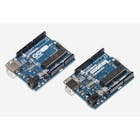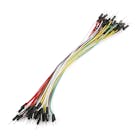25 kHz 4 Pin PWM Fan Control with Arduino Uno © GPL3+
DESCRIPTION
I have been wondering about this project and how to control my 4 pin PWM fans. I had 5 laying around and thought mine as well give it a shot. The frequency values can be adjusted between 125 HZ -- 8 MHZ as well as a variable duty cycle. The circuit utilizes the mode 10 PWM phase-correct on timer 1 OCR1A (Pin 9) and ICR1 (Pin 10). Some debugging was needed to figure out this and I do own a handheld oscilloscope. It makes seeing the frequencies and duty cycles much easier and no guessing is involved. Here's the link: The Oscilloscope.
I do strongly advise you look up the datasheet for your fan as the control pin in my case was yellow (Which is normally referred as tach wire). Be sure to also find the acceptable frequency range for your chosen fan. You may need to change the code frequency to adjust to your needs. Finally you will need a good power supply (Mine is a converted ATX PSU from an old PC).
I have been wondering about this project and how to control my 4 pin PWM fans. I had 5 laying around and thought mine as well give it a shot. The frequency values can be adjusted between 125 HZ -- 8 MHZ as well as a variable duty cycle. The circuit utilizes the mode 10 PWM phase-correct on timer 1 OCR1A (Pin 9) and ICR1 (Pin 10). Some debugging was needed to figure out this and I do own a handheld oscilloscope. It makes seeing the frequencies and duty cycles much easier and no guessing is involved. Here's the link: The Oscilloscope.
I do strongly advise you look up the datasheet for your fan as the control pin in my case was yellow (Which is normally referred as tach wire). Be sure to also find the acceptable frequency range for your chosen fan. You may need to change the code frequency to adjust to your needs. Finally you will need a good power supply (Mine is a converted ATX PSU from an old PC).








